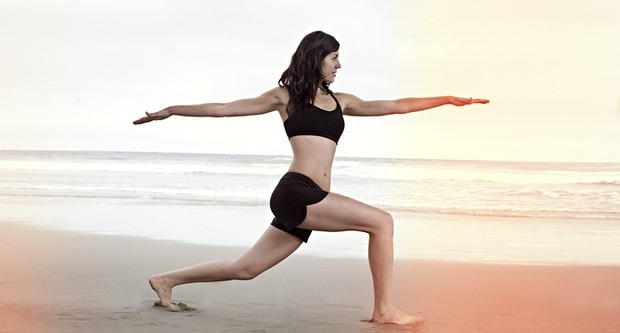Ashtanga is considered to be an austere and disciplined branch of yoga. For one, it involves following a set sequence yoga poses throughout the session. In Ashtanga, these sequences include asanas or poses that range from forward bends, standing balances, twists, inversions, backbends, and much more.
An example of the sequences done in Ashtanga yoga is the Sun Salutation Series (Surya Namaskar), which is also considered as one of the fundamentals of the asanas branch of yogic practice. The Sun Salutations A and B are warm ups to the subsequent Ashtanga Yoga poses as they ease the joints, increase blood flow to the heart, promote early sweating and gently stretches the body in preparation of a challenging practice ahead.
What do they warm you up for? The following will give you an idea of what takes place in the Primary Series (there are three, each more difficult than the last) of Ashtanga yoga.
Vinyasas
Parts of these sequences are used in between Ashtanga Yoga poses to link them together, especially towards the latter end of the Primary Series. In Ashtanga, these are referred to as vinyasas, and they are basically comprised of a jump back to a Low Plank Pose (Chaturanga Dandasana), transitioning to Upward Facing Dog Pose (Urdhva Mukha Svanasana), and then to Downward Facing Dog (Adho Mukha Svanasana) before jumping through to the next pose.
Traditionally, these vinyasas are done after the 18 standing poses and in between every pose (sometimes on both sides) for the rest of the Series. In a regular 90 minute class, you can do upwards of 40 vinyasas—this ensures that you have enough upper body and core strength to prep you for inversions like the headstand at the end. The vinyasas also serve to reset your body for the next pose.
Triangle Pose (Trikonasana) and Twisted Triangle Pose (Parivritta Trikonasana)
These standing Ashtanga Yoga poses emphasize creating angles, specifically triangles with the extended limbs of your arms and legs.
To get into Trikoasana, stand with your feet about 4 feet apart, with the right foot pointed forward and the other at a 45-degree angle in the same direction. Outstretch your arms and extend forward over your hip. Place your right hand on your shin, or if you can, grab your big toe with your peace fingers and pull. Lift your other arm straight up so that it forms a line perpendicular to the floor.
Keep your tailbone down as you try to stack the left side of your hip over your right side. Also, open up your chest so that your shoulders and collarbone open up. This is a great pose for your posture, and it opens up the hip and teaches balances as well.
In Parivritta Trikonasana, the reverse arm goes outside the leading foot. It is more challenging in terms of hip alignment and keeping balance, but it is a good pose for stretching hamstrings and since it is a twist, it also awakens the spine in preparation for backbends.
Intense Hand to Big Toe Pose (Utthita Hasta Padangushtasana)
This is one of the most difficult standing balancing poses. You need to have a great sense of concentration as well as balance to keep this pose for the length of time it takes.
First, stand on your left leg, with your left arm on your waist for support. Take your right big toe with your right peace fingers and extend it forward. There is a pulling motion with your arm and your feet that takes place that helps stabilize you. Bend forward and try to touch your chin to your shin. If you can, straighten up and externally rotate your still lifted leg to the side.
For a deeper challenge, look over your left shoulder, and try not to fall out of the pose as your focus shifts. After a few breaths, go back to the center, bend forward for a breath, and straighten up again. Now let go of your foot and let it stay as high up as possible on its own. Then you can lower the foot and switch sides.
Sage Forward Bend A (Marichyasana A)
The first of a series of seated twists, this is a great pose for stretching the inner hip and groin area, but keep in mind that twists can be intense for the belly area, so make sure you don't have too much to eat before your practice (in fact, Ashtanga is traditionally practiced in the morning as the sun rises, before breakfast).
Seated with your legs outstretched in front of you, bend your right leg so that your foot is planted on the floor about a fist distance away from your left thigh. Now bend forward with your right arm outstretched and make a sweeping gesture around your bent leg so that it wraps around it. Now make a similar movement with your left arm so that your hands meet at your back.
If you can, bind one hand to the other wrist. Otherwise, use a towel or strap. As you inhale straighten your back, and with an exhale, bend forward, keeping your left leg active by lifting your kneecaps, engaging your thighs, and flexing your foot. As you release, do a vinyasa, and do the same thing on the other side.
These are but a few Ashtanga Yoga poses of the many, many asanas that comprise Ashtanga yoga. It is certainly physically demanding, but incredibly rewarding as well, especially if you make it a habit and see your progression every day. The nice thing about Ashtanga is that it has a logic and order to it, so that each pose prepares you for the next one.
So with enough practice, you'll be able to do all these poses and even the more seemingly impossible ones like the Ashtangi you have the potential to be.


